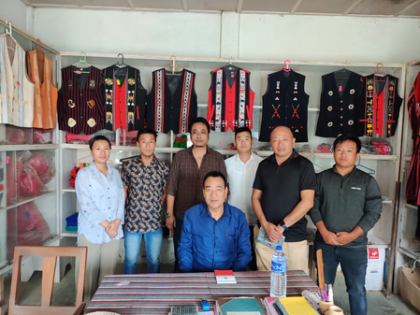Nagaland CM emphasises preserving, promoting rich traditions of state’s 17 tribes
By IANS | Updated: June 6, 2025 22:03 IST2025-06-06T21:56:28+5:302025-06-06T22:03:18+5:30
Kohima, June 6 Nagaland Chief Minister Neiphiu Rio on Friday emphasised the need to preserve, expand and promote ...

Nagaland CM emphasises preserving, promoting rich traditions of state’s 17 tribes
Kohima, June 6 Nagaland Chief Minister Neiphiu Rio on Friday emphasised the need to preserve, expand and promote the rich traditions of the state's 17 tribes and multiple sub-tribes.
Inaugurating a seven-storey facility to serve as a hub for Naga handloom, handicrafts, and cultural promotion, the Chief Minister also highlighted the cultural and economic importance of the new facility, calling it a "beacon of identity and opportunity".
The 7-storey facility of the Nagaland State Emporium Complex in Kohima is a landmark initiative to promote and preserve the rich handloom and handicrafts tradition of the state.
Rio said: "Our state’s diversity, embodied in over 17 major tribes, gives rise to a rich tapestry of customs, attire, and traditional artistry. Every motif and weave tells a story. We must preserve and promote these with authenticity and pride."
The Chief Minister further urged for proper documentation and quality control in the sector, noting the need to archive traditional songs, artefacts, textiles, and cuisines.
"Authenticity must not be diluted. Designs must be approved by tribal authorities before production. Let us protect the integrity of our culture even as we adapt for broader markets," he said.
Rio also advocated collaboration between professional designers and local artisans, promotion of Naga cuisine, and structured systems for value addition.
"Let us not merely export raw materials, but create finished products that showcase the richness of our traditions,” he said while calling on private and government partners to invest in skills, institutions, and marketing efforts that elevate Nagaland’s craftsmanship to global standards.
Nagaland Handloom & Handicrafts Development Corporation Ltd (NHHDC) Chairman Prasielie Pienyu noted that the inauguration 7-storey building marks not just the completion of a structure, but the realisation of a long-cherished vision.
"This new complex stands as a symbol of our cultural pride, the resilience of our artisans, and the economic potential of the handloom and handicrafts sector in Nagaland," he said.
Pienyu highlighted that the Corporation has earlier established emporiums in Delhi, Kolkata, and five districts across Nagaland, serving as vital platforms to showcase and sustain the state’s traditional crafts.
"These emporiums go beyond commerce - they reflect our values, support local livelihoods, and carry forward our cultural legacy," he said.
One of the key highlights of the day’s event was the formal launch of the Naga Unity Shawl, an initiative aimed at visually representing the collective identity of the Naga people across tribal lines.
While every tribe in Nagaland has its distinct traditional shawl, the idea of a common shawl representing Naga unity had long been envisioned. The Unity Shawl has now been conceptualised and woven at the Weaving Production Centre of NHHDC Ltd., Dimapur.
The men’s shawl is designed in three panels, with the top and bottom panels featuring the commonly used Naga colours—black, red, and white. The central panel is white, bordered with black and adorned with painted or embroidered motifs that symbolise elements common to all Naga tribes. The women’s shawl is a single-panel design divided into three sections. The top and bottom feature multicoloured stripes reflecting the colour palette seen across Naga women’s attire. The central white section includes motifs inspired by traditional ornaments and crafts, signifying the artistry and strength of Naga women.
The shawls were unveiled as a step towards building a shared visual symbol of unity among the diverse tribal communities of the state.
Disclaimer: This post has been auto-published from an agency feed without any modifications to the text and has not been reviewed by an editor
Open in app